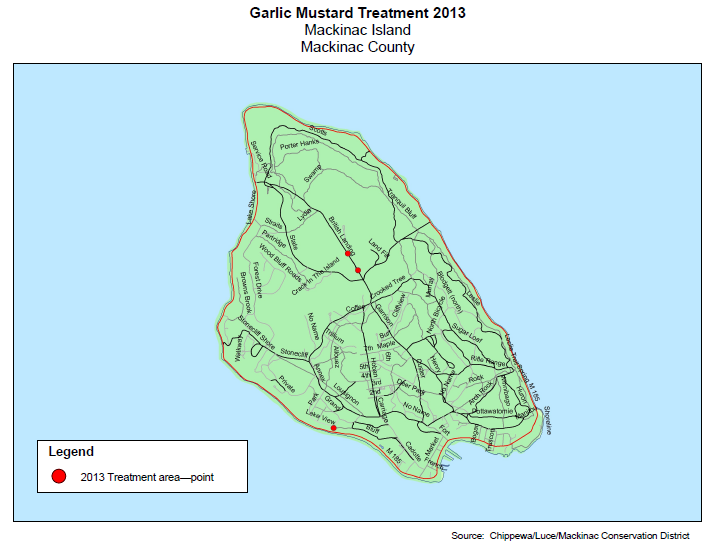A CITO event on Mackinac Island. Be ready for hills and rolling terrain.
Be sure to check out the event being held this weekend too. 12th Annual Spring Fling on Mackinac Island
Come out for a CITO event to help keep Mackinac Island beautiful. There will be several task covered by this CITO event. To claim an "Attended" log, you will only need to complete one of the tasks.
When
Saturday April 28, 2018
From 10:00 am - 4:00 pm
Where
All over Mackinac Island.
I am collecting plastic shopping bags and hope to have a fair number of them to hand out.
What To Bring
Task #1 - Garlic Mustard Removal
A dandelion picker.
Gloves.
Knee pads
Plastic shopping bags for the Garlic Mustard.
Task #2 - Garlic Mustard Marking
GPS.
Task #3 - Trail Side Trash Removal
Plastic shopping bags for trash.
Task #4 - Trail Maintenance
Hand pruners.
GPS to mark fallen trees.
Agenda
Your task to claim an "Attended" log will be to complete at least one of the following task, which can be done any time from 6:00am April 27th thru 5:00pm April 29th.
Task #1 - Garlic Mustard Removal
The child waypoint, Garlic#1 is the location of where I currently know of, where Garlic Mustard is growing. I have heard from the park's manager that two other locations have been found. I'll posted an "Announcement" log when I have that information. We will look for and remove every Garlic Mustard plant we can find. Trash bags will be provided to collect the plants. Bring your own dandelion picker, gloves and knee pads. Garlic Mustard is a ground hugging biennial that will be green at this time of the year.
Task #2 - Garlic Mustard Marking
As we hit the island's trails, please keep your eye open for Garlic Mustard plants. If you spot even a single plant, mark it's location with your GPS and remove it. Put it in to a plastic bag for later disposal. Garlic Mustard can be a tough plant to kill. Just pulling it out of the ground and then tossing it back on the ground can allow the tap root to grow back into the soil.
Task #3 - Trail Side Trash Removal
This is very simple to do. As you are out caching the island, Have plastic shopping bags with you to collect trash that you find along your route. Disposal site are noted below as child waypoints. Any trash can you happen to pass will also work.
Task #4 - Trail Maintenance
Another simple task to do. This one will require you to bring your own hand pruner. As you are out caching the island, and come across any plant growth that is over the trail, prune it back. Toss the cuttings off of the trail. Also part of this task is if you find a tree that has fallen over the trail that you can't clear, please mark a waypoint of it. Then give me that waypoint and a brief description of what it is (fallen tree, fallen rocks) and I'll pass it on to the park's manager.
And now for some information about this plant.
Very Important
To properly remove Garlic Mustard, the entire above ground and the tap root in the soil must be removed. A dandelion picker is one of the best tools the pry the tap root from the soil. The tap root can be brittle and can leave some of the tap root to grow again. When you have removed a Garlic Mustard plant correctly, all of the roots will end as hair thin. If any of the roots have a broken or stop with a stubby end, then some of that root is still in the ground. I will answer any questions you may have on removing Garlic Mustard.
Background
Garlic Mustard was first recorded in the United States about 1868, from Long Island, New York. It was likely introduced by settlers for food or medicinal purposes.
Description
Garlic Mustard [Alliaria petiolata] is a cool season biennial herb with stalked, triangular to heart-shaped, coarsely toothed leaves that give off an odor of garlic when crushed. First-year plants appear as a rosette of green leaves close to the ground. Rosettes remain green through the winter and develop into mature flowering plants the following spring. Flowering plants of Garlic Mustard reach from 2 to 3 1/2 feet in height and produce button like clusters of small white flowers, each with four petals in the shape of a cross.
Garlic Mustard Biology and Life Cycle
It most often grows in the forest understory or along forest edges but is also able to invade undisturbed forest habitats. It tolerates low light levels and is adapted to take advantage of disturbed habitats such as trails, roadsides and areas where trees have been removed. Garlic Mustard has no significant natural enemies in North America, although a diverse community of herbivores feed on it in its native range in Europe. Populations of Garlic Mustard can spread rapidly. In a study of high quality woodlots, i.e. typically old growth or undisturbed forest habitat in Illinois, Garlic Mustard advanced an average of about 20 feet per year, expanding as much as 120 feet in one year. When established, Garlic Mustard becomes a permanent member of the community, often dominating the ground layer habitat over extensive areas.
Garlic Mustard appears to alter habitat quality for several species of salamanders and mollusks through changes in forest litter layer depth and composition. Insect communities are also impacted by the presence of Garlic Mustard. The native woodland butterfly Pieris napi oleraceae, utilizes the native toothworts Cardamine concatenata [Dentaria laciniata] and C. [Dentaria] diphylla, which produce the chemical attractant sinigrin. This compound is also present in Garlic Mustard. Because Garlic Mustard grows taller than the native hosts, in mixed stands the butterflies can mistakenly lay their eggs on Garlic Mustard where their larvae are unable to develop. The impacts of Garlic Mustard on vertebrates are largely unknown, however, ground foraging birds, amphibians and reptiles may be impacted by changes in habitat quality.
First Year Plants
Garlic Mustard reproduces only by seed. Most seeds germinate within the first or second year after being produced but can remain viable in the soil seed bank for up to five years. Seeds require prolonged exposure to cold before they can germinate. Seeds germinate in the spring and form low growing rosettes of dark purple to green, kidney-shaped leaves with scalloped edges. Leaves grow on stalks that are a half to 2 inches long called petioles. Young leaves smell distinctly of garlic or onion when crushed, although the odor becomes less intense as plants grow older. Seedling density in infested areas can reach nearly 17,000 per square yard in the fall, although overwintering mortality is high and rosette density in the spring averages 25 to 70 per square yard, but occasionally reaches as high as 375 per square yard.

Second Year Plants
Leaves on second year plants are roughly triangular and sharply toothed, a little over one to three inches wide and long becoming gradually smaller towards the top of the stem. As with first year plants, young leaves smell distinctly of garlic or onion when crushed, although the odor becomes less intense as plants grow older.
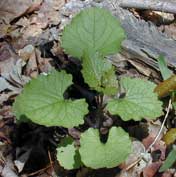
Shoot elongation from the rosette occurs in the spring, with the plant growing as rapidly as three-quarters of an inch per day. Flowers are continuously produced at the top of the long stalk. Flowering occurs in late April through June in southern Michigan. Flowers are white with four petals that form a cross. The flower is similar to others in the Mustard family with six stamens: two long and four short. Petals taper sharply toward the base of the flower
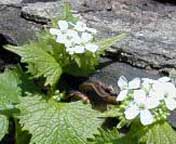
Individual plants produce from 350 to 7,900 seeds and grow to 3 to 4 feet in height. Seeds are produced inside slender pods called siliques. Each silique is approximately 1/16 of an inch wide and one to two and a half inches long and forms off the stem just below the flowers.
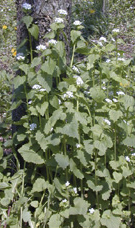
Siliques grow on short, rugged stalks and radiate out from the stem. Wind dispersal is limited and most seeds fall within a few yards of the plant. Dense stands can produce about 12,500 seeds per square yard each year. Humans transport seed on boots, clothing, hair, by mowing, in automobiles and trains. Birds, rodents and whitetail deer are likely seed dispersers in woodland habitats. Garlic Mustard seeds can remain viable in the soil seed bank for up to five years.
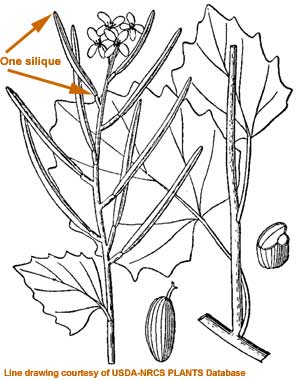
Ecological Threat
Garlic Mustard poses a severe threat to native plants and animals in forest communities in much of the eastern and midwestern U.S. Many native widlflowers that complete their life cycles in the springtime (e.g., spring beauty, wild ginger, bloodroot, Dutchman's breeches, hepatica, toothworts, and trilliums) occur in the same habitat as Garlic Mustard. Once introduced to an area, Garlic Mustard out competes native plants by aggressively monopolizing light, moisture, nutrients, soil and space. Wildlife species that depend on these early plants for their foliage, pollen, nectar, fruits, seeds and roots, are deprived of these essential food sources when Garlic Mustard replaces them. Humans are also deprived of the vibrant display of beautiful spring wildflowers.
In West Virginia, the white butterfly (Pieris virginiensis) lays it's eggs on a plant of spring wildflowers known as "toothworts" (Dentaria), also in the Mustard family. These plants are the primary food source for the caterpillar stage of this butterfly. Invasions of Garlic Mustard are causing local extirpations of the toothworts, and chemicals in Garlic Mustard appear to be toxic to the eggs of the butterfly, as evidenced by their failure to hatch when laid on Garlic Mustard plants.
